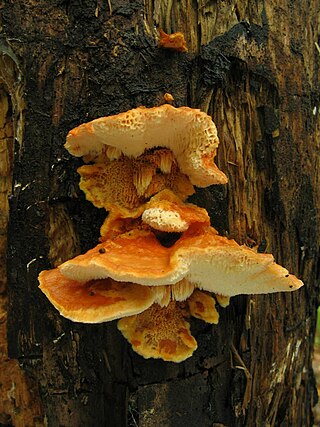
The Polyporales are an order of about 1800 species of fungi in the division Basidiomycota. The order includes some polypores as well as many corticioid fungi and a few agarics. Many species within the order are saprotrophic, most of them wood-rotters. Some genera, such as Ganoderma and Fomes, contain species that attack living tissues and then continue to degrade the wood of their dead hosts. Those of economic importance include several important pathogens of trees and a few species that cause damage by rotting structural timber. Some of the Polyporales are commercially cultivated and marketed for use as food items or in traditional Chinese medicine.

Helina is a very large genus from the fly family Muscidae.

The Polyporaceae are a family of poroid fungi belonging to the Basidiomycota. The flesh of their fruit bodies varies from soft to very tough. Most members of this family have their hymenium in vertical pores on the underside of the caps, but some of them have gills or gill-like structures. Many species are brackets, but others have a definite stipe – for example, Polyporus badius.

Donkioporia is a genus of fungi in the family Fomitopsidaceae. The genus consists of two resupinate (crust-like) species: the type Donkioporia expansa, and D. albidofusca, which was transferred to the genus in 2010.

Pericyma is a genus of moths in the family Erebidae. The genus was erected by Gottlieb August Wilhelm Herrich-Schäffer in 1851.

Phylidorea is a genus of crane flies in the family Limoniidae.
Pericyma squalens is a moth of the family Noctuidae first described by Julius Lederer in 1855. It is found in south-eastern Turkey, Iran, Iraq, Afghanistan, Turkmenistan, Kuwait, Saudi Arabia, Egypt, Lebanon, Israel and Jordan.

Dichomitus is a genus of poroid crust fungi in the family Polyporaceae. It was circumscribed by English mycologist Derek Reid in 1965.

Phylidorea squalens is a species of cranefly in the family Limoniidae
Megachile squalens is a species of bee in the family Megachilidae. It was described by Haliday in 1836.
Dichomeris squalens is a moth in the family Gelechiidae. It was described by Edward Meyrick in 1914. It is found in Guyana and Brazil.
Arthur John "A.J." Bliss (1862–1931) was a British iris breeder who is credited with greatly improving the genetics of many modern strains, especially those descending from his Dominion cultivar.

In Finland, Kotiranta and Niemelä introduced a widely used method for comparing the conservation values of different forest areas, based on the observation that certain wood-rotting fungi are very sensitive to the impact of human activities on forest ecosystems. Such species are slow to return to areas from where they have disappeared, so their presence is evidence of a long continuity in forest ecosystems.
Gamasomorpha is a genus of goblin spiders in the family Oonopidae, containing sixty three accepted species.
Dichomitus hubeiensis is a crust fungus that was described as a new species in 2013. The fungus is characterized by the cream to straw-yellow pore surface and large pores numbering 1–2 per millimetre. Microscopic features include both inamyloid and indextrinoid skeletal hyphae, the presence of cystidioles and dendrohyphidia in the hymenium, and roughly ellipsoid spores that measure 10–14 by 5.6–7.0 µm. The specific epithet refers to the type locality in Hubei, central China.
Dichomitus eucalypti is a crust fungus that was described as a new species in 1985 by Norwegian mycologist Leif Ryvarden. The fruit body of the fungus measures 1–2 cm in diameter, and has a white to pale cream pore surface with small round pores numbering 2–3 per millimetre. D. eucalypti has a dimitic hyphal structure, containing both generative and binding hyphae. Generative hyphae are thin walled with clamps, and measure 2.5–4 μm in diameter. Found in the context, the binding hyphae are solid, hyaline, and measure 2–5 μm. Spores are more or less cylindrical, thin-walled and hyaline, and have dimensions of 7–8.5 by 3–4 μm.
Leifiporia is a genus of two species of poroid white rot crust fungi in the family Polyporaceae. The genus was circumscribed by Chinese mycologists in 2016 to accommodate the type species Leifiporia rhizomorpha.

Diachus is a genus of case-bearing leaf beetles in the family Chrysomelidae. There are about 10 described species in Diachus.
Thinoxenus is a genus of broad-nosed weevils in the beetle family Curculionidae. There is at least one described species in Thinoxenus, T. squalens.









